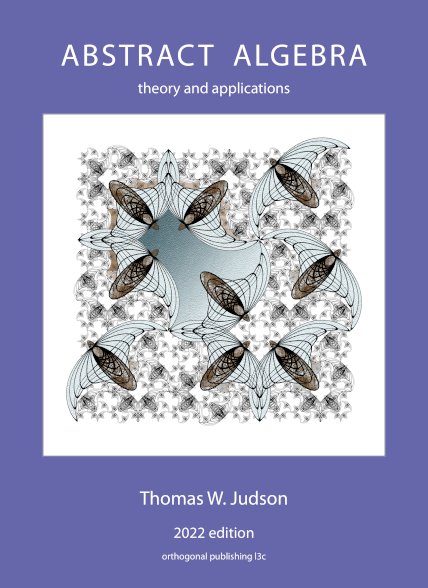Section 15.7 Sage
Subsection Sylow Subgroups
The Sage permutation group method
.sylow_subgroup(p) will return a single Sylow .conjugate(g) will conjugate the group by g.With repeated conjugations of a single Sylow
xxxxxxxxxxdef all_sylow(G, p): '''Form the set of all distinct Sylow p-subgroups of G''' scriptP = [] P = G.sylow_subgroup(p) for x in G: H = P.conjugate(x) if not(H in scriptP): scriptP.append(H) return scriptPLets investigate the Sylow subgroups of the dihedral group
xxxxxxxxxxG = DihedralGroup(18)S2 = G.sylow_subgroup(2); S2xxxxxxxxxxuniqS2 = all_sylow(G, 2)uniqS2xxxxxxxxxxlen(uniqS2)The Third Sylow Theorem tells us that for
Now for the case of
xxxxxxxxxxG = DihedralGroup(18)S3 = G.sylow_subgroup(3); S3xxxxxxxxxxuniqS3 = all_sylow(G, 3)uniqS3xxxxxxxxxxlen(uniqS3)What does the Third Sylow Theorem predict? Just
xxxxxxxxxxS3.is_normal(G)At least one of the subgroups of order
xxxxxxxxxxS3.is_cyclic()Remember that there are many other subgroups, of other orders. For example, can you construct a subgroup of order
Subsection Normalizers
A new command that is relevant to this section is the construction of a normalizer. The Sage command
G.normalizer(H) will return the subgroup of G containing elements that normalize the subgroup H. We illustrate its use with the Sylow subgroups from above.xxxxxxxxxxG = DihedralGroup(18)S2 = G.sylow_subgroup(2)S3 = G.sylow_subgroup(3)N2 = G.normalizer(S2); N2xxxxxxxxxxN2 == S2xxxxxxxxxxN3 = G.normalizer(S3); N3xxxxxxxxxxN3 == GThe normalizer of a subgroup always contains the whole subgroup, so the normalizer of
S2 is as small as possible. We already knew S3 is normal in G, so it is no surprise that its normalizer is as big as possible — every element of G normalizes S3. Let us compute a normalizer in xxxxxxxxxxG = DihedralGroup(18)a = G("(1,7,13)(2,8,14)(3,9,15)(4,10,16)(5,11,17)(6,12,18)")b = G("(1,5)(2,4)(6,18)(7,17)(8,16)(9,15)(10,14)(11,13)")H = G.subgroup([a, b])H.order()xxxxxxxxxxN = G.normalizer(H)NxxxxxxxxxxN.order()So for this subgroup of order
xxxxxxxxxxH.is_normal(G)xxxxxxxxxxH.is_normal(N)Subsection Finite Simple Groups
We saw earlier Sage’s permutation group method
.is_simple(). Example 15.16 tells us that a group of order DiCyclicGroup(16) is a non-abelian group of xxxxxxxxxxDC=DiCyclicGroup(16)DC.order()xxxxxxxxxxDC.is_simple()xxxxxxxxxxns = DC.normal_subgroups()len(ns)Here is a rather interesting group, one of the
13
web.mat.bham.ac.uk/atlas/v2.0/spor/HSxxxxxxxxxxG = SymmetricGroup(100)a = G([(1,60), (2,72), (3,81), (4,43), (5,11), (6,87), (7,34), (9,63), (12,46), (13,28), (14,71), (15,42), (16,97), (18,57), (19,52), (21,32), (23,47), (24,54), (25,83), (26,78), (29,89), (30,39), (33,61), (35,56), (37,67), (44,76), (45,88), (48,59), (49,86), (50,74), (51,66), (53,99), (55,75), (62,73), (65,79), (68,82), (77,92), (84,90), (85,98), (94,100)])b = G([(1,86,13,10,47), (2,53,30,8,38), (3,40,48,25,17), (4,29,92,88,43), (5,98,66,54, 65), (6,27,51,73,24), (7,83,16,20,28), (9,23,89,95,61), (11,42,46,91,32), (12,14, 81,55,68), (15,90,31,56,37), (18,69,45,84,76), (19,59,79,35,93), (21,22,64,39,100), (26,58,96,85,77), (33,52,94,75,44), (34,62,87,78,50), (36,82,60,74,72), (41,80,70,49,67), (57,63,71,99,97)])a.order(), b.order()xxxxxxxxxxHS = G.subgroup([a, b])HS.order()xxxxxxxxxxHS.is_simple()We saw this group earlier in the exercises for Chapter 14 on group actions, where it was the single non-trivial normal subgroup of the automorphism group of the Higman-Sims graph, hence its name.
Subsection GAP Console and Interface
This concludes our exclusive study of group theory, though we will be using groups some in the subsequent sections. As we have remarked, much of Sage’s computation with groups is performed by the open source program, “Groups, Algorithms, and Programming,” which is better know as simply GAP. If after this course you outgrow Sage’s support for groups, then learning GAP would be your next step as a group theorist. Every copy of Sage includes a copy of GAP and is easy to see which version of GAP is included:
xxxxxxxxxxgap.version()You can interact with GAP in Sage in several ways. The most direct is by creating a permutation group via Sage’s
gap() command.xxxxxxxxxxG = gap('Group( (1,2,3,4,5,6), (1,3,5) )')GNow we can use most any GAP command with
G, via the convention that most GAP commands expect a group as the first argument, and we instead provide the group by using the object-orientedG. syntax. If you consult the GAP documentation you will see that Center is a GAP command that expects a group as its lone argument, and Centralizer is a GAP command that expects two arguments — a group and then a group element.xxxxxxxxxxG.Center()xxxxxxxxxxG.Centralizer('(1, 3, 5)')If you use the Sage Notebook interface you can set the first line of a compute cell to
%gap and the entire cell will be interpreted as if you were interacting directly with GAP. This means you would now use GAP’s syntax, which you can see above is slightly different than Sage’s universal syntax. You can also use the drop-down box at the top of a worksheet, and select gap as the system (rather than sage) and your whole worksheet will be interpreted as GAP commands. Here is one simple example, which you should be able to evaluate in your current worksheet. This particular example will not run properly in a Sage Cell in a web page version of this section.Notice that
- We do not need to wrap the individual permutations in as many quotation marks as we do in Sage.
- Assignment is
:=not=. If you forget the colon, you will get an error message such asVariable: 'G' must have a value - A line must end with a semi-colon. If you forget, several lines will be merged together.
You can get help about GAP commands with a command such as the following, though you will soon see that GAP assumes you know a lot more algebra than Sage assumes you know.
xxxxxxxxxxprint(gap.help('SymmetricGroup', pager=False))In the command-line version of Sage, you can also use the GAP “console.” Again, you need to use GAP syntax, and you do not have many of the conveniences of the Sage notebook. It is also good to know in advance that
quit; is how you can leave the GAP console and get back to Sage. If you run Sage at the command-line, use the command gap_console() to start GAP running.It is a comfort to know that with Sage you get a complete copy of GAP, installed and all ready to run. However, this is not a tutorial on GAP, so consult the documentation available at the main GAP website: www.gap-system.org to learn how to get the most out of GAP.
14
/www.gap-system.org
